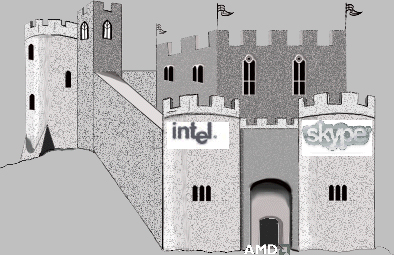Why is Skype giving AMD the second-class treatment?


As I reported here yesterday, Skype and Intel have been working together in an alliance to power and enable advanced Internet calling features. The first evidence of this is a new conference calling capability in Skype 2.0 for up to 10 people.
Some of my colleagues have been taken aback by the fact that this 10-caller capability only works on Windows-based machines running Intel dual-core chips.
If your machine does not have these newer Intel chips, or runs on Intel-rival AMD processors, why, then, you only get the opportunity to run five-way conferences over your Skype 2.0.
Emails have been going back and forth between several of us at ZDNet about the nature of and motive behind what sure sounds like favoritism on Skype's part toward Intel, and a corresponding lack of respect for AMD, the vendors whose machines run it and those machine's owners. That could mean you.
One colleague seems to think that this greater conference calling capacity for Intel dual-core 'puters is simply evidence of a perfectly legit alliance between Skype and Intel- an alliance that might even involve payments by Intel for this preferential treatment.
Another colleague looks beyond the "alliance-as-professional-treatment" argument, toward what one read of his comments might infer as an inference that Skype has undertaken deliberate under-the-hood moves to "lock out" AMD dual cores and other CPUs from enabling 10-user conferencing on those machines.
My colleague - whose name you would instantaneously recognize, believes that Skype would have had to deliberately prevent AMD dual-core CPUs from working for more than five Skype 2.0 conference call participants by giving 2.0 the ability to detect the CPU ID and then implement various rules that would come to life should more than five folks attempt to join the Skype 2.0 conference call on a non-Intel dual-core powered computer.
So to distill the issue at hand, is the ballyhooed 10-participant capability of Skype 2.0 powered by the latest and greatest Intel chips a marketing-driven selling point, or the result of an attempt to institutionalize this capability by putting under-the-hood speed bumps in the way of AMD chips that under unimpeded circumstances, would be perfectly capable of powering a Skype 2.0, 10-party conference call?
I sort of think some of both. The "most-favored processor" status conferred by Skype on Intel dual-core sounds very much like a marketing-driven message to me, perhaps reinforced on the technical side by a couple of under-the-hood tweaks to maximize performance.
Still, we have all seen marketing-driven alliances that take the next step and put minor,yet highly effective technical obstacles in the way of non-alliance solutions that would seek to implement the same level of performance or feature-set.
But one colleague thinks the argument is more than a bit academic. This colleague, who generally tends more to executive matters than writing stuff you are likely to read on these URLs, says that in his entire career he has never had the need to participate in a 10-person conference call. For the record, I have, but maybe that's not the real point.
Although my colleague with the impressive title doesn't say so outright, he sounds like he thinks this 10-participant capacity is like those sports car commercials that show those vehicles going 140 around a hairpin curve. You'll never try that at home but cool to know your machine can do this.